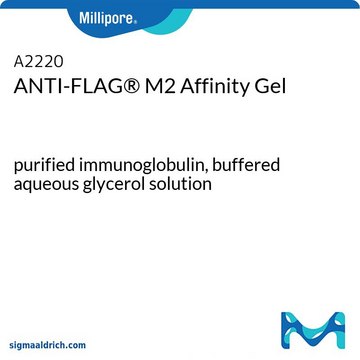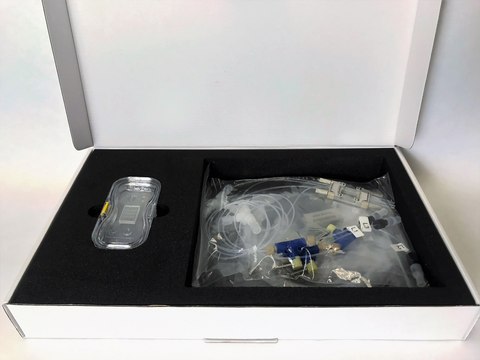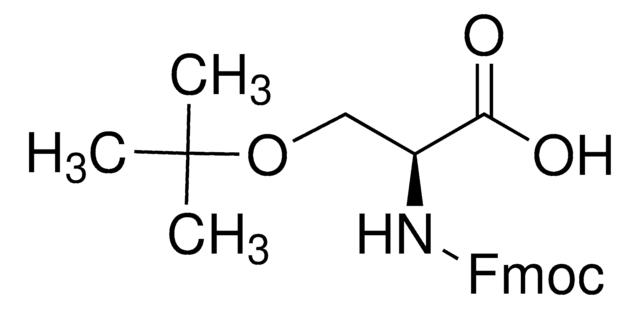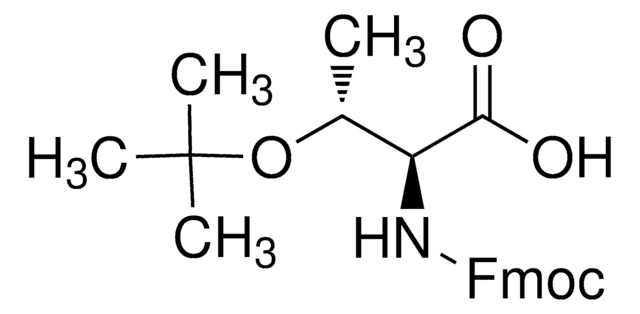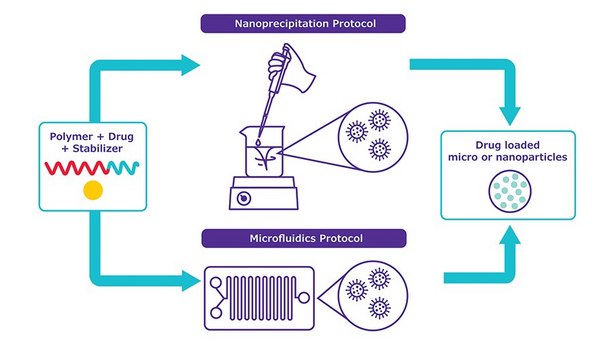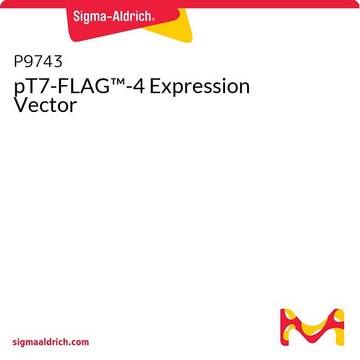推荐产品
标签
FLAG® tagged
表单
buffered aqueous solution
分子量
size 4247 bp
菌种筛选
kanamycin
复制起点
pUC (500 copies)
肽切割
no cleavage
肽标签位置
N-terminal
启动子
Promoter name: CMV
Promoter activity: constitutive
Promoter type: mammalian
报告基因
none
运输
ambient
储存温度
−20°C
一般描述
This plasmid adds a FLAG epitope tag to the N-terminus of a protein that is encoded within the multiple cloning site. This tag allows the detection and purification of a tagged protein using antibodies raised against the FLAG epitope. The FLAG tag coding sequence is DYKDDDDK. There is an enterokinase cleavage site (DDDDK) within the FLAG tag sequence that can be used to remove it from a purified protein if required. It cleaves after the lysine residue.
Promoter Expression Level: This plasmid contains the mammalian CMV promoter to drive gene expression. We have tested all of our mammalian promoters in a range of cell types and CMV is consistently the strongest in those we have studied. However there are many reports of the CMV promoter demonstrating silencing by methylation in long-term culture.
Promoter Expression Level: This plasmid contains the mammalian CMV promoter to drive gene expression. We have tested all of our mammalian promoters in a range of cell types and CMV is consistently the strongest in those we have studied. However there are many reports of the CMV promoter demonstrating silencing by methylation in long-term culture.
应用
Cloning in a gene: This vector has been designed to allow the addition of a peptide tag to the end of a protein of interest using standard cloning techniques.Multiple Cloning Site Notes:
There is a start codon in the NcoI site can be removed by digestion with KpnI if required. The MCS for gene insertions extends from NotI to XbaI however the tag resides between the NotI and HindIII sites. There are Shine-Dalgarno sequences and KOZAK sequences aligned with the start codon of the peptide tag.
The ClaI to NheI sites have other functions such as adding C-terminal peptide tags second promoters or IRES expression components. The BsgI and BseRI restriction sites cleave within the stop codon in the XbaI site and allow the retrospective fusion of C-terminal peptide tags sequences if the stop codon is placed in this position.
There is a start codon in the NcoI site can be removed by digestion with KpnI if required. The MCS for gene insertions extends from NotI to XbaI however the tag resides between the NotI and HindIII sites. There are Shine-Dalgarno sequences and KOZAK sequences aligned with the start codon of the peptide tag.
The ClaI to NheI sites have other functions such as adding C-terminal peptide tags second promoters or IRES expression components. The BsgI and BseRI restriction sites cleave within the stop codon in the XbaI site and allow the retrospective fusion of C-terminal peptide tags sequences if the stop codon is placed in this position.
序列
To view sequence information for this product, please visit the product page
分析说明
To view the Certificate of Analysis for this product, please visit www.oxgene.com
法律信息
FLAG is a registered trademark of Merck KGaA, Darmstadt, Germany
相关产品
产品编号
说明
价格
储存分类代码
12 - Non Combustible Liquids
闪点(°F)
Not applicable
闪点(°C)
Not applicable
法规信息
新产品
Diana Romero et al.
Carcinogenesis, 37(1), 18-29 (2015-10-28)
Dickkopf-3 (Dkk-3) is a secreted protein whose expression is downregulated in many types of cancer. Endogenous Dkk-3 is required for formation of acini in 3D cultures of prostate epithelial cells, where it inhibits transforming growth factor (TGF)-β/Smad signaling. Here, we
Geoffrey M Lynn et al.
Nature biotechnology, 33(11), 1201-1210 (2015-10-27)
The efficacy of vaccine adjuvants such as Toll-like receptor agonists (TLRa) can be improved through formulation and delivery approaches. Here, we attached small molecule TLR-7/8a to polymer scaffolds (polymer-TLR-7/8a) and evaluated how different physicochemical properties of the TLR-7/8a and polymer
Jin-Gyoung Jung et al.
PLoS genetics, 10(10), e1004751-e1004751 (2014-10-31)
The Notch3 signaling pathway is thought to play a critical role in cancer development, as evidenced by the Notch3 amplification and rearrangement observed in human cancers. However, the molecular mechanism by which Notch3 signaling contributes to tumorigenesis is largely unknown.
Alexander C Cerny et al.
PLoS genetics, 11(10), e1005578-e1005578 (2015-10-29)
Recycling of signaling proteins is a common phenomenon in diverse signaling pathways. In photoreceptors of Drosophila, light absorption by rhodopsin triggers a phospholipase Cβ-mediated opening of the ion channels transient receptor potential (TRP) and TRP-like (TRPL) and generates the visual
我们的科学家团队拥有各种研究领域经验,包括生命科学、材料科学、化学合成、色谱、分析及许多其他领域.
联系技术服务部门

